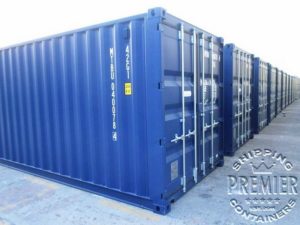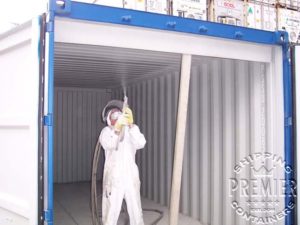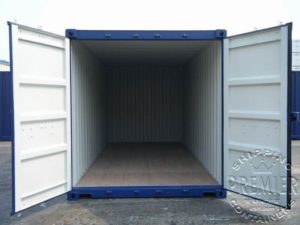With so many inner city ‘brown field’ sites available at the moment, we are seeing a rapid increase in the number of self-storage operations starting up. But is there really that much business out there? Well with the increase in people running their own businesses on sites like EBay, Gumtree and Shpock they do need somewhere to securely store their stocks. Further, with less and less storage space in new-build homes, storage space is at a premium and if you’re running a business and need additional storage space then, using a shipping container in a secure self-storage facility is a quick and cost-effective option.
So if you are considering opening up your own self-storage operation, we hope that some of the following information we’ve gathered over the years is of value to you.
1. If you own unused land, a self-storage business is an excellent investment
Based on current market rates for self-storage rental, buying a new/one trip shipping container with delivery to your site will roughly take around 2-years to begin making a profit unless your business model uses a longer amortization period (for the cost of the containers) then you’ll be running at a profit in a much shorter time. After this, and for the next 10-20 years life of the container, nearly all the money earned from your venture will be profit. And if you carry out regular maintenance on the container such as cleaning debris off the roof and re-paint it with a good quality marine grade paint say, every 2-3 years you’ll help to extend the life of the containers plus, a smart looking container depot is going to encourage more business.
The majority of our customers who’ve set up their own self-storage facility tell us that whilst they have some customers who only require short-term rental, they are typically replaced very quickly by new customers.
2. Survey your local area, check for competitors and choose your location carefully
Clearly advertised self-storage businesses in prominent positions on busy streets will see a larger proportion of trade compared to a business tucked away down a (low traffic) side-street with relatively poor access and visibility to passing traffic. Being in a prominent position keeps your advertising costs to a minimum too.
 It’s always a very good idea to check out competitors in the area to understand where potential customers already go to store their goods and to give you an understanding of local charges for storage. Will your chosen location be in a better position and more visible, with convenient access compared to the existing facility? If you meet these criteria, there’s a very good chance that you’re in a strong position to outdo the local competition.
It’s always a very good idea to check out competitors in the area to understand where potential customers already go to store their goods and to give you an understanding of local charges for storage. Will your chosen location be in a better position and more visible, with convenient access compared to the existing facility? If you meet these criteria, there’s a very good chance that you’re in a strong position to outdo the local competition.
Another consideration to look into is who will use your new business? For instance, are there any new property developments nearby? Very often, we hear that areas with new properties are a good place to establish a new facility, as newer properties have less storage space than older properties.
Are their many small business units or office nearby? Very often smaller businesses will see their storage requirements go up as their business grows and in ‘peak-periods’ such as the run up to Christmas and any other seasonal events such as, Easter, Eid al-Fitr etc.
If you want an even better in-sight in to the potential of your local market, you might consider asking local business owners and even home owners about their self-storage requirements.
3. We would recommend only using new/one trip shipping containers
Whilst shipping containers are made of a special steel alloy, called Corten Steel (as used to construct the Angel of the North), we advocate the use of new shipping containers as they will require little maintenance and should last from 15 to 20 years. Customers will subconsciously be influenced by the look of your facility, including the look of the containers, and a neat tidy facility will draw customers in. We should also mention that an established facility will find it very much easier to get finance for additional containers when required.
4. Choose one respected supplier and choose from one container range and a standard colour for your containers
There are a number of container manufacturers who all produce very good quality 20ft and 40ft containers. However, the design of the container will vary by producer. For instance, some producers fit 4 locking bars whilst others only fit 3 locking bars to the cargo doors. Other things that can vary between producers are the number of vents they fit as standard and where they buy their container paint.
If you choose to work with us, we will always provide clear information about what you are getting including how often stock gets refreshed and how reliable (and competitive) a particular supplier is. By working with us, we have access to a large pool of suppliers so, if our usual supplier is out of stock, we can get alternate containers to almost the same specification as your previous purchases.
5. Always invest in good quality padlocks
We can supply a range of padlocks that can be individually keyed and numbered using a master key system. Once we’ve set-up and recorded the information about your lock and key, you can then buy more padlocks from us knowing that your existing master key will fit these new locks too! Whilst the master-keyed system will be a little more expensive than buying individual locks, in the long-term you’ll benefit from access to any container using your master key so, in the event that someone should fail to pay, you can gain access to any of your containers.
We do know that some self-storage facilities encourage customers to supply their own locks and whilst this may work well for them what do you do if you need to get in to a container? For instance, supposing the police arrive with a search warrant or the customer has lost their keys. In either instance, you’re going to potentially damage your container when attempting to remove the lock box so you can get bolt cutters on to the padlock. Of course, you may find a local locksmith but the cost of their emergency call-out service is far too expensive. By following our advice and having a master keyed system you will avoid these and other potential problems, keeping your business running smoothly.
6. Always set-up standing orders or direct debits with your rental customers
Getting paid by an automated system every month’s advance rental means less administration for you, less calls and less overall hassle leaving you to focus on running your business and it’s a much better option for your customers.
7. Will goods get damaged by condensation?
As you never know what a customer is going to store in your containers, we recommend considering having a method on condensation prevention. In a shipping container or any other building with a single skin metal roof, condensation will form as the dew point increases which can then drip down on to valuable goods.

The most cost-effective method for long-term condensation prevention is by having a special coating called Grafo-Therm applied to the ceiling of the container. This will prevent condensation dripping down on to goods and allow you to rent these units out at a higher rate. There is one important consideration to take in to account here and that is the possible damage that could be caused to the container ceiling due to the moisture being held in the coating and this could shorten the life span of your container. This very much is a ‘worst-case scenario’ and there is very little evidence of this happening but we thought you should know.
If this is a concern to you, we can offer an alternate and temporary solution and these are cargo desiccants. They offer a great short-term solution and you might consider this as an alternative to having any of your containers coated with Grafo-Therm. The desiccant sticks are easy to fit, they simply hang off the cargo lashing hooks and should be replaced every 12-weeks or so depending on weather conditions. They also provide an alternative revenue stream for you as you can sell them to customers who do require some form of condensation prevention. You may also consider selling customers our battery-operated shipping container lights too!
As an up-market alternative, we could insulate and ply-line your containers and whilst it’s an expensive solution, it works well in the long-term.
8. Think carefully about the overall design and lay-out of your self-storage facility
This is a very important point and one that could impact the efficient running of your facility and your ability to get the maximum number of containers on the site. We recommend making a ‘to scale’ plan of your facility, this will save you money in the long-term (it’s easy to move bits of paper around on a plan but expensive getting a haulier in to move containers after the fact).
You’ll want to ensure your customers can easily get their vehicle in and out of your site with ease. And you can make sure you’ve maximised the use of the yard space available.
An innovative idea that’s being taken up by some of our self-storage clients is the use of tunnel containers. Tunnel shipping containers have doors at either end and come in 20ft and 40ft lengths. For example, if someone wants to rent a 20ft container and you’ve only got a 40ft container you could lose a valuable client. Our solution! Use a tunnel shipping container divider. The divider can be fitted and removed in about 30-minutes (with practise) giving you some flexibility and the divider can be used in a 20ft tunnel container to create 2 x 10ft spaces. And in a 40ft, you could make 2 x 20ft spaces or 1 x 30ft and 1 x 10ft storage space.
The divider is installed using tools and it’s unlikely that anyone would tamper with it once in situ.
Whilst you can buy a variety of different sizes of containers from us, we believe that the use of a tunnel container with divider is the most cost-effective solution because buying a dedicated 10ft container is almost as expensive as buying a standard 20ft container.
If you start to run out of ground floor space you might consider stacking additional containers on top of your existing stock and installing a gantry system for your customers to use to gain entry. If you have a fork lift and pallet truck, you can safely lift pallets on to the gantry and if you don’t, offer the upper tier of units at a slightly reduced cost for customers who don’t have to move heavy items up and down the stairs.
Stacking containers enables you to practically double the use of your existing acreage without the need to invest in additional sites.
9. Site presentation
This is a very important point and should never be overlooked. How your business is perceived has a major influence over customer conversion. If your site is messy and poorly arranged, potential customers may never even step in to your reception area.
Potential customers will subconsciously be influenced by what they see so, make sure your site is clean and your reception area is clean, free of clutter and smelling fresh.
Make sure your containers are kept clean (inside and out) and touch-up any paintwork when required. And to extend the longevity of your containers, keep the container roof free of debris and re-paint this (especially) every 2 -3 years.
10. Container flooring
 Not a point that may spring to mind in the first instance but, an important one to consider especially if you want to keep floor maintenance to a minimum. For self-storage use, we’d always suggest that containers with a bamboo floor offer the best long-term solution. Marine ply won’t repel oil so, you could end up with a badly stained floor which could put customers off or you have to replace the panel(s) and, at a cost of around £100.00 per panel, your costs could soon mount up.
Not a point that may spring to mind in the first instance but, an important one to consider especially if you want to keep floor maintenance to a minimum. For self-storage use, we’d always suggest that containers with a bamboo floor offer the best long-term solution. Marine ply won’t repel oil so, you could end up with a badly stained floor which could put customers off or you have to replace the panel(s) and, at a cost of around £100.00 per panel, your costs could soon mount up.
The bamboo used in our shipping containers is a fast-growing eco-friendly variety that’s extremely hard-wearing and it’s non-porous.
One final word of warning!
Never attempt to buy your own shipping containers from China. Whilst it may sound like a good way to keep your costs to a minimum, there are many pitfalls such as:
- How do you know you are dealing with a legitimate supplier?
- What happens when some of your containers go missing in transit?
- What recourse do you have when your containers arrive damaged?
- One container is so badly damaged that it can’t be moved from the port without having a specialist transport company collect it for you.
- Some of your containers were delivered to a different country.
Whilst you may pay a little more sourcing your containers from a UK based supplier, you have minimal waiting time for your containers and with some of our depots, you can even view containers prior to purchase.
If you have any questions about this article, our products or service please call our friendly team for free on 0800 999 8988 any time 08:30-17:00 weekdays or send us a message via the contact form on this website and we will get back to you.

